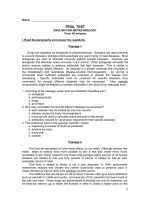bài kiểm tra thử tiếng anh chuyên ngành CNSH
Bạn đang xem bản rút gọn của tài liệu. Xem và tải ngay bản đầy đủ của tài liệu tại đây (93.45 KB, 3 trang )
Name:_____________________________
TRIAL TEST
ENGLISH FOR BIOTECHNOLOGY
Time: 45 minutes
I. Read the paragraphs and answer the questions
Passage 1
Drugs are classified as biologicals or pharmaceuticals. Biologics are used primarily
to prevent diseases, whereas pharmaceuticals are used mainly to treat diseases. Most
biologicals are used to stimulate immunity against specific diseases. Vaccines are
biologicals that stimulate active immunity in the animal. Other biologicals stimulate the
body’s immune system to produce antibodies that fight diseases. This is similar to
immunity through natural infection. An antibody is a protein molecule that circulates in
the bloodstream and neutralizes disease-causing microorganisms. An animal is
immunized when sufficient antibodies are produced to prevent the disease from
developing. Specific antibodies must be produced for specific diseases; thus
vaccination for several different disaeses may be necessary. Also, periodic
revaccination might be needed to maintain antibodies in the blood at an adequate level.
1. According to the passage, which term are antibiotics classified into?
a. biologicals
b. pharmaceuticals
c. drugs
d. all of them
2. Why may vaccination for several different diseases be necessary?
a. each disease may be treated by only one vaccine
b. disease caused by many microorganisms
c. Vaccines are used to stimulate active immunity in the animal
d. antibodies induced by vaccination response for their specific diseases
3. The underlined word in the passage “periodic” means
a. happening a number of times as scheduled
b. anytime we need
c. every year
d. random
Passage 2
The food we eat seems to have many effects on our heath. Although science has
made steps in making food more suitable to eat, it has also made many foods
unsuitable to eat. Some research has shown that perhaps eighty percent of all human
illnesses are related to diet and forty percent of cancer is related to diet as well,
especially cancer of colon.
That food is related to illness is not a new discovery. In 1945, government
researchers realized that nitrates and nitrites (commonly used to preserve color in
meats directly) as well as other food additives caused cancer.
The additives that we eat are not all so direct. Farmers often give some antibiotics
such as penicillin to cattle and poultry, and because of this, penicillin has been found in
the milk and meat. These drugs are administered to animals not only for treatment, but
for financial reasons (i.e to fatten the animals in other to obtain a higher price on the
1
market). Although the Food and Drug Administration has tried repeatedly to control
these procedures, the practices still continue.
4. The underlined word “additives” is closest meaning to
(A) Added substances
(B) Dangerous substances
(C) Natural substances
(D) Colored substances
5. The underlinedword “i.e.” a latin expression refer to
(A) and others
(B) for example
(C) that is
(D) see below
6. What are nitrates used for?
(A) They preserve flavor in packaged foods
(B) They preserve the color of meats
(C) They are the objects of research
(D) They cause the animals to become fatter
7. FDA means
(A) Food Direct Additives
(B) Final Difficult Analysis
(C) Food and Drug Administration
(D) Federal Dairy Additives
8. What is the best title for this passage?
(A) Harmful and Harmless Substances in Food
(B) Improving Health Through a Natural Diet
(C) The Food You Eat Can Affect Your Health
(D) Avoiding Injurious Substances in Food
II Look at the chart anh answer the question
This chart shows the transmission of avian influenza to humans
2
9. Which statement is wrong
a. chicken can get the disease easily when infected
b. human is susceptable with the virus from chicken
c. waterfowl is insusceptable with the virus
d. none of them
10. the word “susceptable” is closest in meaning to
a. ill
b. sensitive
c. sentative
d. emotional
III. Match words in the left column with their characteristics in the right column
1. Larvae A. consist of one cell
2. bovine B. live on or in other animals
3. heterotrophic C. a bacterial infection attacking lungs
4. insects D. a substance or agent causing cancer
5. antibiotics E. including mold and yeast
6. tuberculosis F. an equipment in a laboratory
7. noxious G. belongs to digestive tract
8. carcinogen H. an organic compound (as a vitamin) essential in
minute amounts to the growth and health of an
animal
9. breakdown I. relating to a cow
10. protozoa J. physically harmful or destructive to living beings
11. micronutrients K. the process of decomposing
12. fungus L. any of numerous small invertebrate animals (as
spiders)
13. parasite M. a drug that is used to kill bacteria and infections
14. stomach O. the early form of an animal (as a frog)
15. Bunsen burner N. requiring complex organic compounds of nitrogen
and carbon (as that obtained from plant or animal
matter) for life
3









